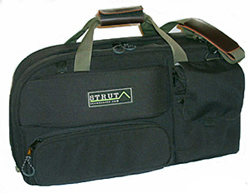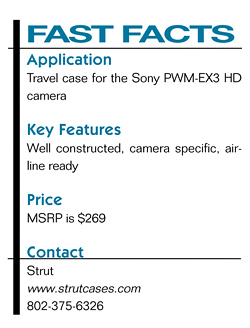Strut Cases GTC-3 Camera Bag
A little less than a year ago I did two things I haven't done before in this business: purchased an HD camera for a documentary project, and embarked on an extensive series of trips to shoot interviews for that project. The camera was Sony's PMW-EX3 and my main concern was being able to put together a compact, multi-function, and rugged kit to cover a wide range of interview situations. Also I needed a package that could be easily carried by one scrawny individual. As I searched for the camera deal, I didn't really find a carrying case specifically made for the EX3 and its somewhat peculiar shape.
There were cases that would fit the unit's overall dimensions, but these would have required me to do some extensive internal padding and adaptations. I really wanted a bag that was designed so the camera could slip in and out of, easily and securely, and one that didn't require a lot of my t-shirts and socks for padding to make it fit.

The Strut GTC-3 camera bag After some amount of searching, I noticed a listing on the Abel Cine Tech Web site for Strut Cases, a new company I'd never heard of. Not only was their GTC-3 model designed for my new camera, the company itself was practically a neighbor, located only about 40 miles away in southern Vermont. I decided to test the case and am here to testify that it served me well for 70,000 miles, and without showing any signs of wear.
FEATURES
The GTC-3 weighs in at about 4.4 pounds without the camera, and measures 22.5 x 9.5 x 11-inches (which allows it to fit into airline overhead storage bins) and it includes a shaped, padded, and reinforced blister for the EX3's viewfinder. The case is constructed of dark green waterproof 1000-denier Cordura, the standard for toughness, and has a washable waterproof, and lint-free, interior of 200-denier nylon oxford. (Denier, by the way, is a measure of the density of weave in fabrics, and thus the fabric's toughness.)
The bag has four outside zippered pockets, which are covered by fold-away storm flaps and have well padded sides and bottoms. There's also one inside pocket.
The case is very easy to carry, either by the webbed and leather handles, which are deeply stitched and reinforced at the top, or by a webbed and leather strap. It's well balanced, and sits evenly on the floor, whether it's full or empty, thanks in part to a fifth "foot" on the bottom center of the bag.
The outside bottom pocket, and the main central compartment where the camera sits, are gusseted to keep them from falling too far open and spilling the contents. And most important of all, the camera rides securely in the main compartment, protected by plastic armored sidewalls and padding, with the viewfinder equally well protected and supported.
IN USE
As soon as I got the case, I happily placed the camera inside. The viewfinder fit perfectly and securely in its armored bubble, but the camera seemed to slip around laterally inside the bag with much more movement than I liked. I made a quick call across the state to John Fairley, proprietor and chief designer of Strut Cases. He answered on the second ring, and had the solution: two little padded cradles that attached by Velcro to the bottom of the case's interior. He shipped them within the hour and I had them the next day. This fix was both fast and perfect; the two pieces formed a very secure bed for the camera and stopped all side-to-side and back-to-front movement. Just for safety's sake—and because I would be lugging the bag and camera through unknown tribulations and airplanes—I added some foam padding on the lens end, making the fit even more solid and secure.

The pockets on a camera bag to me are like time during a production—there?s never enough. Given the truth of this statement, the Strut bag does very well for auxiliary storage space. There are two pocket areas on the same side of the bag as the viewfinder "blister:" The one below the viewfinder turned out to be the perfect size to hold all the batteries I use for the EX-3, along with a battery tester. The one next to the viewfinder is covered by a Velcro-secured weather flap and was the perfect size for the battery charger/power supply, my Tram lavaliere microphone, and lens cleaning supplies. A zippered flat pocket is on the reverse side, which happily holds my Warm Cards, a focus chart, the camera manual, and an EX-3 camera guide. On the inside, a flat pocket holds my recording media: a collection of SxS cards and SDHC cards and the adaptors that make them work with the EX-3.
I carried my camera and bag on and off a lot of planes during my project. These were both regular sized passenger planes and the smaller (and even tiny) commuter short hop planes. The Strut case fit perfectly in the overhead bins of the larger planes. For the smaller (and happily, shorter) flights, it was hit or miss: sometimes the bag fit and sometimes it had not a prayer and had to be checked at planeside. Aside from some scuffing, the bag came through those check ins with less stress than you receive from the constant TSA inspections. Generally the scuffs wiped or brushed right off. And carrying the bag on those incredibly long and heart healthy hikes between gates was very comfortable, thanks to the good balance of the loaded bag and placement of the strap.
SUMMARY
Strut is not a huge company that makes an extensive line of specialized bags, but one that does produce a small, but growing, product line that fits a wide variety of medium sized cameras from Sony, Canon, Panasonic, and JVC (for a full list, visit Strut's Web site). Strut Bags are well designed to protect the camera and be easy to carry and access. The cases are tough and toughly made, and very reasonably priced. I'm sure that you can look forward to many years of service.
Michael Hanish operates Free Lunch, a video/audio/multimedia production house near Guilford, Vt. He may be contacted atmichael@freelunchmedia.com.
Get the TV Tech Newsletter
The professional video industry's #1 source for news, trends and product and tech information. Sign up below.
